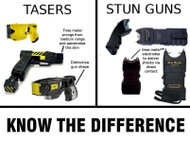Stun Guns vs. TASERs – Important Differences
Posted by Ulrich Faircloth on 25th Nov 2016
Stun guns and TASERs…people they think that they are both one in the same. Both these two electroshock weapons, much like their chemical counterparts (pepper spray and mace), have very significant differences: from design to their effects on the human body.
Stun Guns
The most commonly known electroshock weapon is the stun gun. The stun gun’s early beginnings started with the Leyden Jar and became recognized through the electric prod pole in the late 1800s. The stun gun uses high voltage, low amperage shocks at close range to temporarily disable a person. It is a pain compliance tool, meaning that while it may disrupt the nervous system in a localized area it will NOT cause the entire body to become immobilized.
Stun guns come in all forms and sizes, such as stun gun batons, cell phones, lipstick, flashlights, brass knuckles, walking canes and so on. If you are looking for a stun gun, there is likely a concealable option that will work for you.
The TASER
The Thomas A. Swift Electric Rifle (TASER) is a specific brand of electronic control device (ECD), a creation of TASER International. The TASER is a less-lethal electroshock weapon that was designed to be safer method for law enforcement officers to subdue criminals, but it has also been utilized in self-defense for civilians. Several models have been created, including the TASER BOLT, TASER C2, TASER M26, TASER X26, TASER X26P, TASER X2, TASER X3, and TASER X12.
Other electronic control devices have been created since the inception of the TASER, such as PhaZZer Electronics-branded ECDs such as the PhaZZer Enforcer and Karbon Arms’ MPID unit. All ECDs are designed to lock up the body involuntarily with high voltage, low amperage shocks.
Stun Guns vs. TASERs
- Stun guns are close-contact devices; TASERs can shoot from up to 35 feet away, but can also become stun guns in “drive stun” mode.
- Stun guns are pain compliance tools, making them a poor choice against someone who has a high tolerance to pain (such as someone under the influence of drugs or alcohol); TASERs can cause the body to lock up involuntarily through neuromuscular incapacitation (NMI).
- Stun guns must be held directly on the skin for 3-5 seconds in order to be effective; TASERs work immediately, as soon as both dart probes hit the body.
- Stun guns use metal electrodes to directly affect the skin; TASERs utilize nitrogen-propelled metal prongs to hit an attacker from a distance.
- Stun guns have no documented cases of killing anyone; TASERs do, through misuse or overuse.
- Stun guns are cheap ($20 - $110); TASERs are expensive ($400+)
- Stun guns do not look like guns, TASERs do.
The Winner?
The TASER ECD is clearly the winner here. The ability to temporarily immobilize someone without relying on pain to do so, and at a distance, makes it the best choice for self-defense when compared to a regular stun gun. Just having a TASER can make a statement, as just saying the word “TASER!” can make a criminal flinch; many know what to expect.
Though it comes with an expensive price tag, you typically pay for what you get. The TASER is no exception here. The only problem is if you miss your target or if one of the prongs does not hit the person.
Looking for a stun gun or TASER for yourself or a loved one? Stun & Run Self Defense has the best selection to choose from!

 Menu
Menu
 Item(s)
Item(s)
